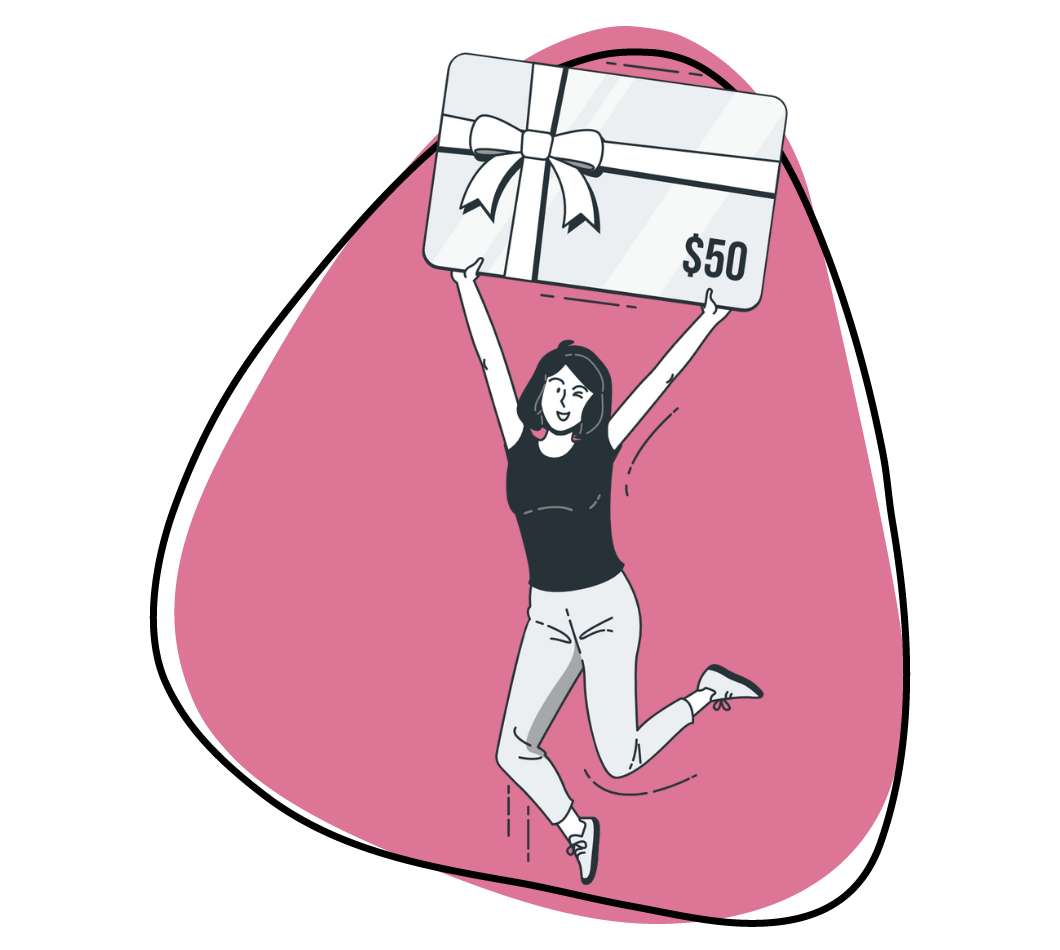The SaaS industry is one of the most competitive today. If you are offering your software as a service, you need to do more to keep your subscribers happy and satisfied to reduce churn. Wondering how? You need the best customer success strategies that work for SaaS.
Read on as we tell you what these are, and share the best tools to help you implement them. But first, what is customer success and why is it important to your business?
What Is Customer Success in SaaS?
Customer success in Software-as-a-Service (SaaS) is a customer-centric approach that ensures customers achieve their desired outcomes with your product or service. Unlike traditional customer support, customer success is proactive, focusing on understanding and fulfilling customer needs. It involves monitoring customer engagement, providing ongoing support, and fostering growth and retention.
In the SaaS industry, customer success is vital for building strong, long-term relationships with customers – it’s not merely about resolving issues but also creating a seamless and satisfying experience that encourages loyalty and contributes to long-term business success. By aligning the product or service with the customer’s goals, SaaS companies can enhance satisfaction and maximize the value delivered, leading to increased renewals and revenue growth.
To start implementing this approach, you will need to have the best customer success team, tools, practices, and strategies. A customer success team will handle onboarding and the continuous communication with your customers, while tools will help you implement your customer success strategy. Read on for more.
The Main Components of Customer Success in SaaS
In SaaS, customer success is your compass, guiding your business toward growth and prosperity. It’s a multifaceted discipline that involves several key components, each crucial in ensuring customer satisfaction with your product or service. Here are the main ones:
I. Foundation (Onboarding)
Onboarding is the initial stage where your customers get acquainted with your product. It involves your customer success team setting up user accounts, assisting with data migration, and providing one-on-one training and user support. A smooth onboarding process is critical for fostering product adoption and customer satisfaction.
II. Success Planning
Like a blueprint guides the construction process, a success plan outlines your customer’s objectives and your strategies to meet them. Your customer success team will create a roadmap tailored to each customer to understand their expectations, identify their pain points, and craft a customized activation plan.
III. Self-service Content
In your customer success strategy, you need to ensure self-service if possible. Self-service empowers customers through technical knowledge bases, training modules, and online resources. With it, your customers can find most of the information they need and only reach out tio your customer success manager when they can’t solve their issues independently.
IV. Playbooks
These are strategic guides that outline the standardized procedures, best practices, and methodologies that the customer success team should follow.
They ensure your customer success teams are aligned and equipped to handle various customer interactions, fostering consistency, efficiency, and a unified approach to achieving customer satisfaction and success.
V. Feedback Channels
These are channels for your customers to voice their experiences and concerns. They play a crucial role in flagging recurring product issues so you can improve your software and increase customer trust.
VI. Quarterly Business Reviews
Regular check-ins with your customers ensure that the success plan is on track. These reviews provide an opportunity to discuss product usage, customer satisfaction, and any significant challenges they face.
Why is Customer Success Important for SaaS Companies?
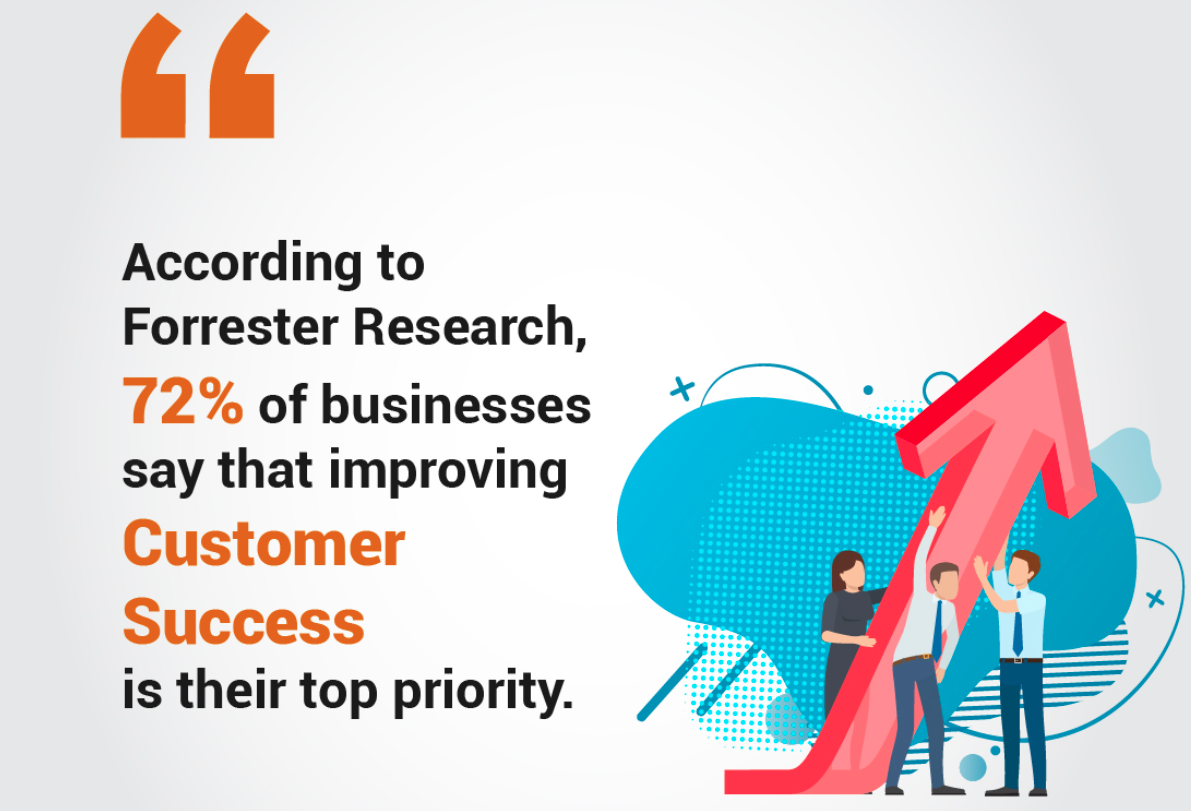
SaaS is a competitive industry, so companies need the best customer success strategy to cut through the noise. Customer success is the driving force that propels a SaaS company from merely surviving to thriving. But why is it so crucial?
Firstly, customer success directly impacts customer retention. In the subscription-based SaaS model, customer churn can be a significant setback. So, planning customer success helps reduce churn by enhancing customer satisfaction and loyalty. When customers succeed with your product, they are more likely to continue their subscription, leading to a steady stream of recurring revenue.
Then, customer success fosters organic growth through upselling and cross-selling opportunities. Satisfied customers are more open to exploring additional features, products, or services that can further enhance their experience. This increases the customer’s lifetime value and contributes to your company’s growth.
Finally, customer success fuels word-of-mouth marketing and advocacy. Happy customers become brand ambassadors, recommending your product to their network. This not only lowers customer acquisition costs but also brings in customers who are likely to be a good fit for your product.
7 SaaS Customer Success Best Practices
As you embark on SaaS customer success, it’s essential to understand the best practices that can guide your journey. With the best practices, you will be one step closer to keeping your customers satisfied and working with them longer. Here are seven practices to get you started:
1. Get Everyone Involved
You may have a customer success team, but they’re only part of the effort. Everyone should be working toward a better relationship with your customers. Leadership can meet and advise and your sales team should be invested in how your customers’ sales are proceeding. Wherever you can help, you can win more business.
2. Make Education Easy
Your SaaS company grows when your software is easy to use. Knowledge is part of that equation. So, you want to give as much training as possible and keep it as simple as you can. We recommend snippets and short videos designed to answer specific feature questions.
You’re only a useful partner if your customers can incorporate your software into their workflows with minimal disruption and significant gains in areas like efficiency.
3. Put Customer Needs First
SaaS companies have a lot of moving parts. It’s easy to get caught up managing those and focus on the features or fixes of the platform, but these aren’t always what the customer needs. Every review and update should look at what customers tell you. Prioritize what’s important to them, not necessarily what you or your customer success team thinks is important to your product.
4. Feedback Should be Easy Too
You have to know customer needs to put them first. So, prioritize feedback channels and give customers multiple options to reach out. Plus, you’ll want to monitor what’s being said about you in other locations, from social media posts and channels on Reddit to industry forums, support groups, and professional associations.
Expanding feedback beyond customer surveys and emails is often an overlooked SaaS customer success best practice because you’ve got to be proactive. However, doing your research as well as asking customers directly can deliver high-quality insight.
5. Remember your ‘Rules’
There are two incredibly important rules for your SaaS operations: The Golden Rule and the Rule of 40. The Golden Rule should guide your interactions from timely responses to saying “thank you” and sharing knowledge as you gain it.
The Rule of 40 is that you will need at least one specific customer success manager for every 40 clients. Your team gets overwhelmed when you have more clients-per-rep, so customers start slipping through the cracks. Most SaaS Companies already think about the rule of 40% — covering their cash flow — so building this customer success rule target reinforces both rules and makes it easier to think about as you grow.
6. Map the Customer Journey
To put your customers first, your customer success manager needs to know what path they’re taking. They need to run through your systems and processes to see what your customer sees during the purchase process. Go from awareness to the decision to renew a contract or agreement. Mapping every connection with your company helps you see gaps and where to improve interactions.
This mapping should focus on the renewal stage because that’s where your customer will most harshly evaluate whether your SaaS solution is contributing to their success.
7. Review Your Market
We all want to immediately say “yes,” but at the same time, this question usually causes someone to crop up in the back of our minds. That client that takes too much time or always needs different support from everyone else. There’s often a client that we can help do a task but not necessarily help be successful.
Your customer success manager needs to review your existing clients to see who your best customer success stories are. Then, ensure this is the group you’re targeting with marketing efforts. As platforms grow, markets change.
In the logistics space, some warehouse management SaaS platforms have grown into larger ERP and even CRM brands. When they made this jump, the people who could use their software shifted significantly in size, scope, and industry. The longer the delay for marketing and sales to adapt to customer and product changes, the slower your growth.
10. Customer Success Strategies for SaaS Businesses
A customer success strategy for SaaS businesses should be tied to specific goals around your customers, both from their perspective and that of your business. You want to develop tools, systems, and processes that help everyone achieve specific goals because these are easier to understand, track, and refine.
So, we’ll look at 10 strategies that revolve around a specific goal or objective. Your implementation will vary (you might focus on feedback via reviews or social media), but the aim is the same: make the customer happier and satisfied with what you do for them, either directly or indirectly.
1. Train to Increase Customer Use and Success
Improving training is one of the best customer success strategies in any SaaS industry. Simplify manuals and processes. Break up tasks with clearer steps. And make everything you offer (blogs, videos, images, walkthroughs, FAQS, etc.) searchable.
However, you can ramp this up even more to help your customers by framing support and training around their specific real-world uses. Don’t just demonstrate how to run a process. Also, show why it’s important and how it improves the lives or operations of the customers.
Look at features and dashboards to see what insights the end customer will get and why they will see it as a benefit. Train your clients to see your software as part of their customer service tools, and you’ll be clearly demonstrating your value in their success.
2. Publicly Celebrate Customer Feedback
SaaS companies are always asking for feedback to guide the improvement and development of software. Some of your best ideas likely came from customer surveys. This information can be great for marketing and improving your customer success efforts.
When possible, tie each specific improvement or change to the customer(s) who mention it. Publicly thank them when you implement these updates.
After implementation, follow-up. Ask all customers to see if these changes improved their sales, operations, or other efforts. Take the customers who said yes and ask for their story (and potentially develop a case study).
Talking to customers about improvements gets them to look at specific metrics and gains. So, you might clearly help them see that you’ve boosted sales or efficiency by 10%. Congratulate your customer on this publicly when possible because it gives them bragging rights too!
Your best-case scenario is when a single customer makes a suggestion, you implement it, and then they see measurable improvements. In this scenario, the entire case study becomes a celebration of them and how great of a partnership you have.
3. Customer Loyalty, Building, and Recognition
Now, it’s time to narrow your focus. All customers want to be heard, so you want feedback from the bunch. However, it’s often just a few select customers that will give you the best information. Focus on a relationship and rapport here through the celebration mentioned above and other loyalty efforts.
Maximizing your feedback potential and improving the loyalty of these specific customers starts with creating a list of preferred clients. For this group, move through the entire customer journey, asking them what works, what doesn’t, and what’s important to them.
Plan to do this quarterly!
For these customers, speak directly about their end-customer success needs and consider offering loyalty program benefits. This might mean having a small user group conference or giving them early access to features. You don’t need to give away the store, but the benefits should be something you’d like from a software vendor.
4. Plan to Address Churn
Some users are always going to churn, no matter what you do. Reach out to these customers to understand why and then build to address that for other users. Profile these customers too, and you might identify trends that are a precursor to churn — such as not responding to emails or even fewer helpdesk requests.
During these conversations, ask specifically about end-customer success. You’ll get unabashed access to frustration in the area, which can help with your customer success efforts.
You may also face cost frustration in the SaaS space as companies scale with you. A smart practice is to automatically flag accounts that might save money when they switch subscription models. Stopping customers from paying overages can significantly boost their satisfaction and allow your software to continue to be a tool they use to support end customers.
5. Remove Customer Barriers
Customers want a product that is easy to use and understand. For customer success, you’ve got to test your system to see how simple you are or if things are unnecessarily getting in the way. While you will get some customer feedback to help with this, you should also perform your own tests with paid groups.
This is a SaaS customer success best practice because you’re not putting the burden on customers. Get groups to test existing functionality and compatibilities to see what they might find frustrating. Look for ways to improve interactions, especially if your customers use your tools during their end-customer support.
Fresh eyes are a wonderful way to continually deliver more streamlined functionality because they aren’t used to doing a process a certain way. Existing customers may overlook a potential issue because they’re trained on your system. Someone new can help you look for opportunities to turn 3 steps into 1.
Thanks to the growing world of APIs and small RPA tools, your best bet might be to find opportunities to reduce steps via automation.
6. Support their End-Customer Service
Every department you have plays a role in customer success. So, for your customers, all of their departments play a role in end-customer success. Your software directly supports their end-customer service capabilities.
Build and train with this understanding in mind. Marketing and training should highlight how and where you provide better end-customer service. If you reduce manual tasks, for instance, tell your partners that it gives their agents more time to address end-customer issues. Fewer steps mean less chance for distraction or human error, likely increasing end-customer service rates.
Speak the language of their business and end-customers, especially when you can tie it to your clients’ KPIs. It’s a simple and direct way to demonstrate your value.
7. Go Beyond Your Software
This customer success strategy tosses your SaaS solution right out the window. You need to be a partner even when that’s no longer in the picture, and this is often accomplished by educating customers on related topics.
DoubleDutch’s customer success approach is a notable example of this mentality. The company builds apps for specific events. They’re focused on building attendee interaction and providing materials to everyone quickly and efficiently. However, events only last so long, so the impact needs to be big.
To address this, DoubleDutch trains groups and companies on how to market their events, both online and in-person, at an event. It also has simple guides for how the app can be used for speakers before and during their presentations or how to position marketing and information differently if it is an internal versus external meeting. They also provide tools to generate reports, nurture the community via email, and how to conduct polls.
There’s a lot of added value in working with the company because its internal experts are willing to share their knowledge about the entire process of running an event, not just how an app helps an event.
8. Implement Predictive Analytics
In the ever-competitive SaaS landscape, predictive analytics is a strategic tool, transforming reactive customer support into a proactive and tailored success strategy.
By analyzing historical data and identifying patterns, predictive analytics allows customer success managers to anticipate potential issues or opportunities.
For example, if a customer’s usage of a particular feature declines, predictive analytics can flag this trend, enabling proactive engagement to understand the underlying cause and offer support. Similarly, it can identify customers who might benefit from additional features or services, leading to targeted upselling. This approach enhances customer success and satisfaction and fosters a more personalized and efficient customer experience.
9. Offer Tailored Solutions and Customization
This customer success strategy in SaaS acknowledges the unique needs of each customer. For instance, a healthcare SaaS might customize data reporting for different medical facilities, while a marketing automation platform could allow businesses to integrate their branding.
The strategy enhances the product’s value by providing personalized experiences, fostering satisfaction and loyalty. By recognizing and catering to individual needs, SaaS companies create a product that resonates with each customer, building long-term success and loyalty.
10. Enhance Collaboration and Communication
With this customer success strategy, you want to create a bridge between your valued customers and your customer success teams. When you implement customer success software, you create a centralized platform where customer success teams can seamlessly interact with customers and amongst themselves.
This software serves as a hub, housing all customer interactions, feedback, and history, allowing for a more personalized and efficient response. It fosters real-time collaboration, ensuring the right information reaches the right person at the right time.
The Tools You Need for Customer Success in Saas
Here are our best four customer success tools you can use:
1. Zight (formerly CloudApp)
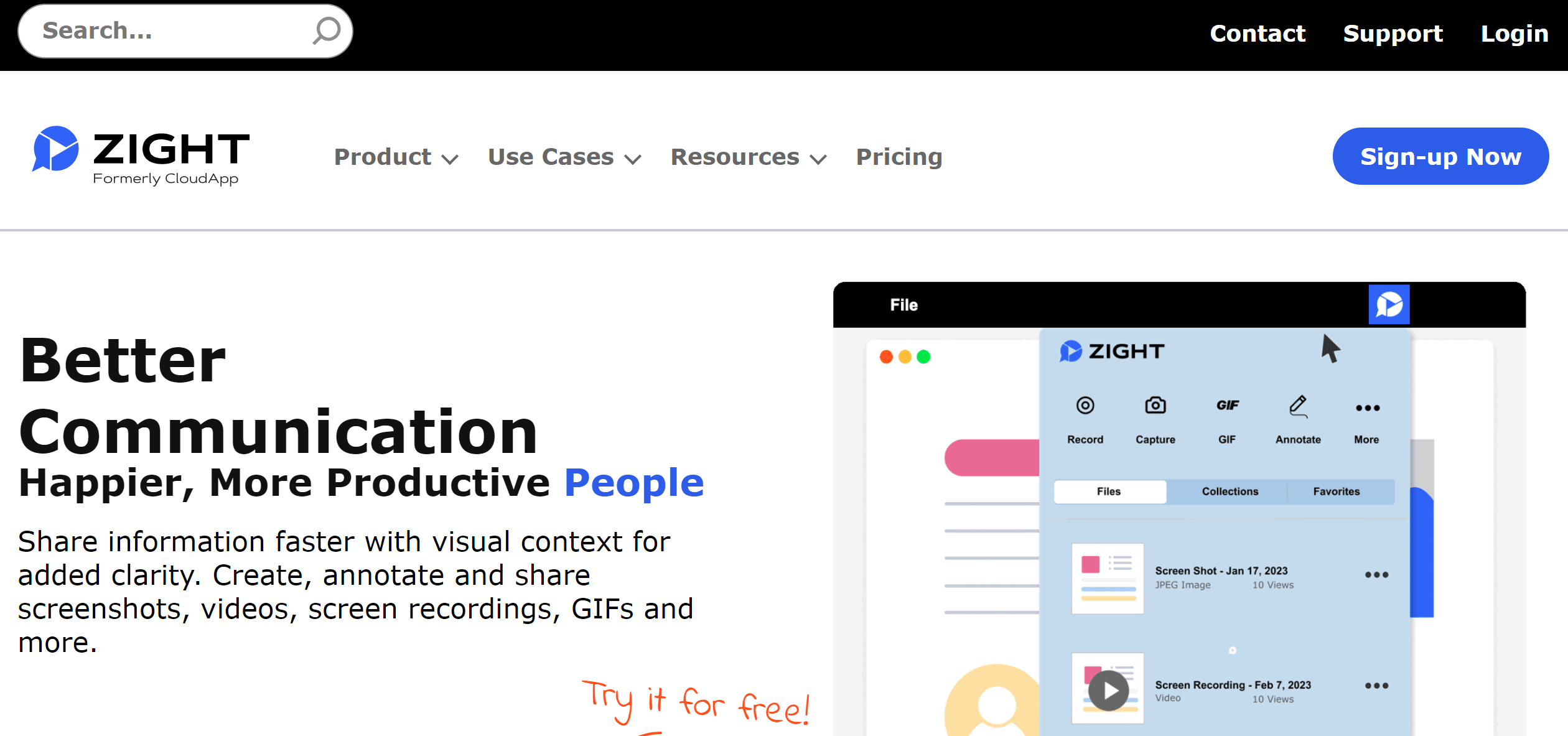
Zight is a versatile tool that offers a range of features designed to enhance the efficiency and effectiveness of your customer success team. It provides a unified application for screenshots, videos, screen recordings, and GIFs, eliminating the need to juggle multiple solutions or meetings. This all-in-one approach simplifies capturing and sharing visual content, making it easier for a customer success team to communicate intricate instructions and respond to customer queries effectively.
Also, when customer success managers create content with Zight, they can create folders to store and organize their creations, making it easier to find and share items with team members. The Collections feature can significantly improve team collaboration and productivity, making it a valuable tool for customer success teams.
The Analytics feature of Zight provides valuable insights into how content is being viewed. Customer success managers can see how many views their content has received and who has viewed it. This helps them understand how their content is used and identify SaaS customer success areas to improve.
Zight also allows easy embedding of content without writing any code. This makes it easy to share content in various locations, including email, website, messaging threads, and more, increasing its visibility and reach.
With these features, Zight ensures you are proactive when providing support to ensure the best customer success. Not only can you close customer support tickets faster, you can also answer questions before the customer asks directly. You can be proactive to drive customer and end-customer success by optimizing customer support workflows too.
2. Gainsight
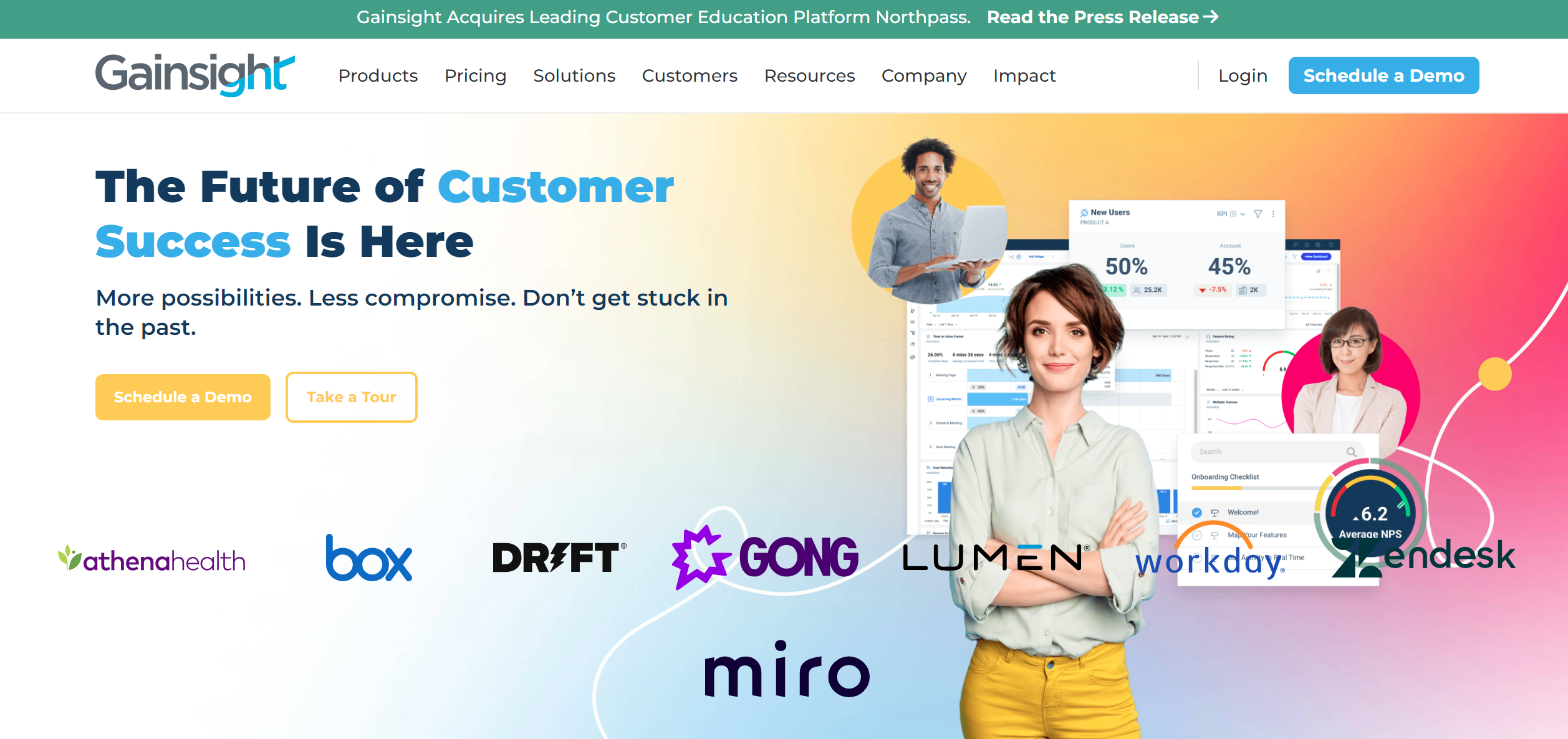
Gainsight centralizes your customer data, allowing for powerful integrations and the ability to push data and power activities using Gainsight APIs. The platform is designed to mirror your business’s customer structures, managing multiple products, deployments, or services you’ve sold to a customer in combination with their account hierarchy.
The platform focuses on digital customer success, offering solutions for retention, expansion, product adoption, and more. It also emphasizes the importance of self-service success, creating opportunities for customers to learn, share, and drive success themselves. Gainsight’s approach to customer success is about finding the perfect balance between human and digital touches, making every customer feel valued.
For SaaS companies looking to enhance collaboration and communication, Gainsight provides tools to improve productivity, increase healthy customer rates, and drive scale and efficiency through self-service and automation.
3. ChurnZero
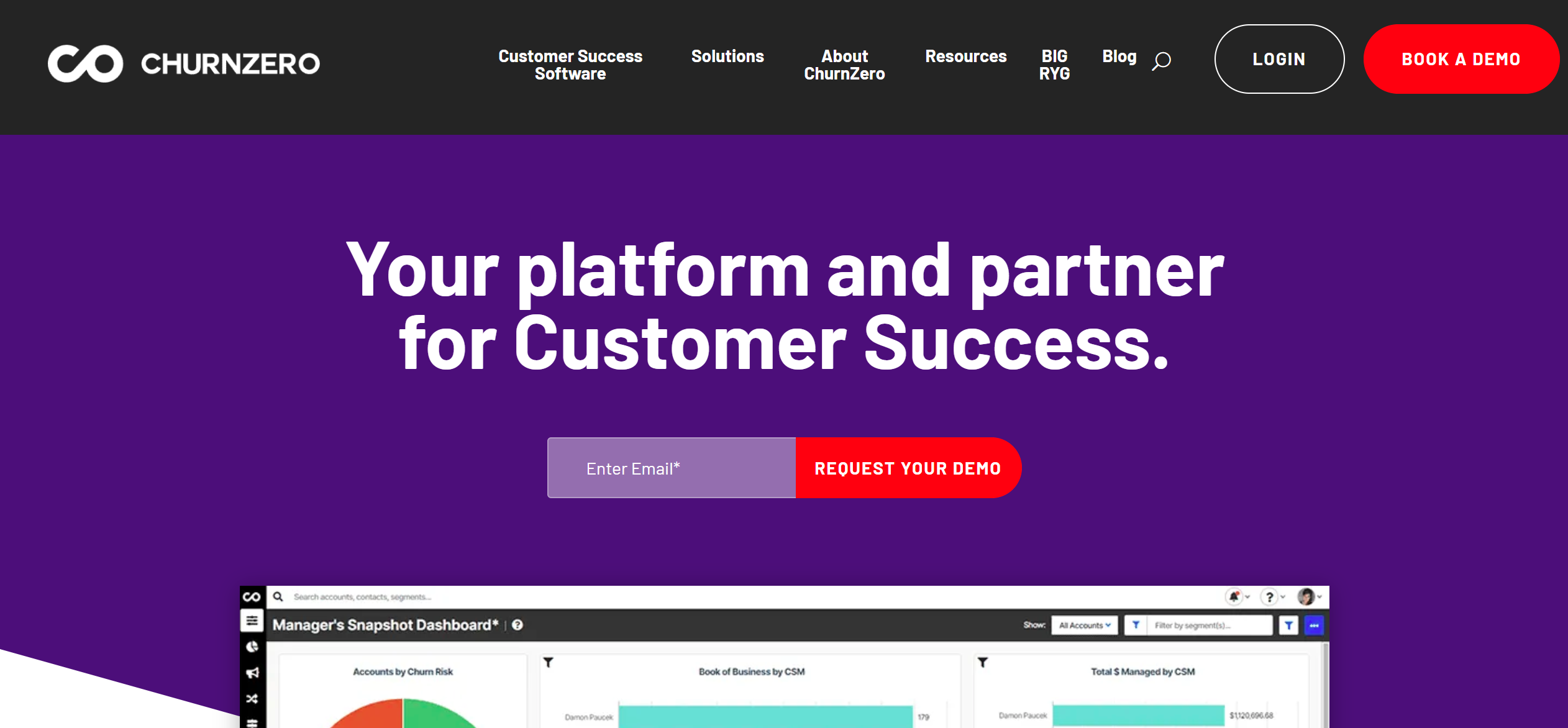
ChurnZero is a real-time Customer Success platform that helps subscription businesses fight customer churn. Its software solutions allow businesses to understand how their customers use their products, assess their health and their likelihood to renew, and give businesses the means to personalize the customer experience through timely and relevant touchpoints.
ChurnZero is uniquely designed to integrate with tech stacks and operate in real-time, providing a 360-degree view of the customer. It offers features like customer health scoring, automated playbooks, customer journey tracking, NPS surveys, and more. These features allow SaaS companies to monitor customer usage and engagement, identify at-risk customers, automate tasks, and gain insights to drive customer success.
4. Totango
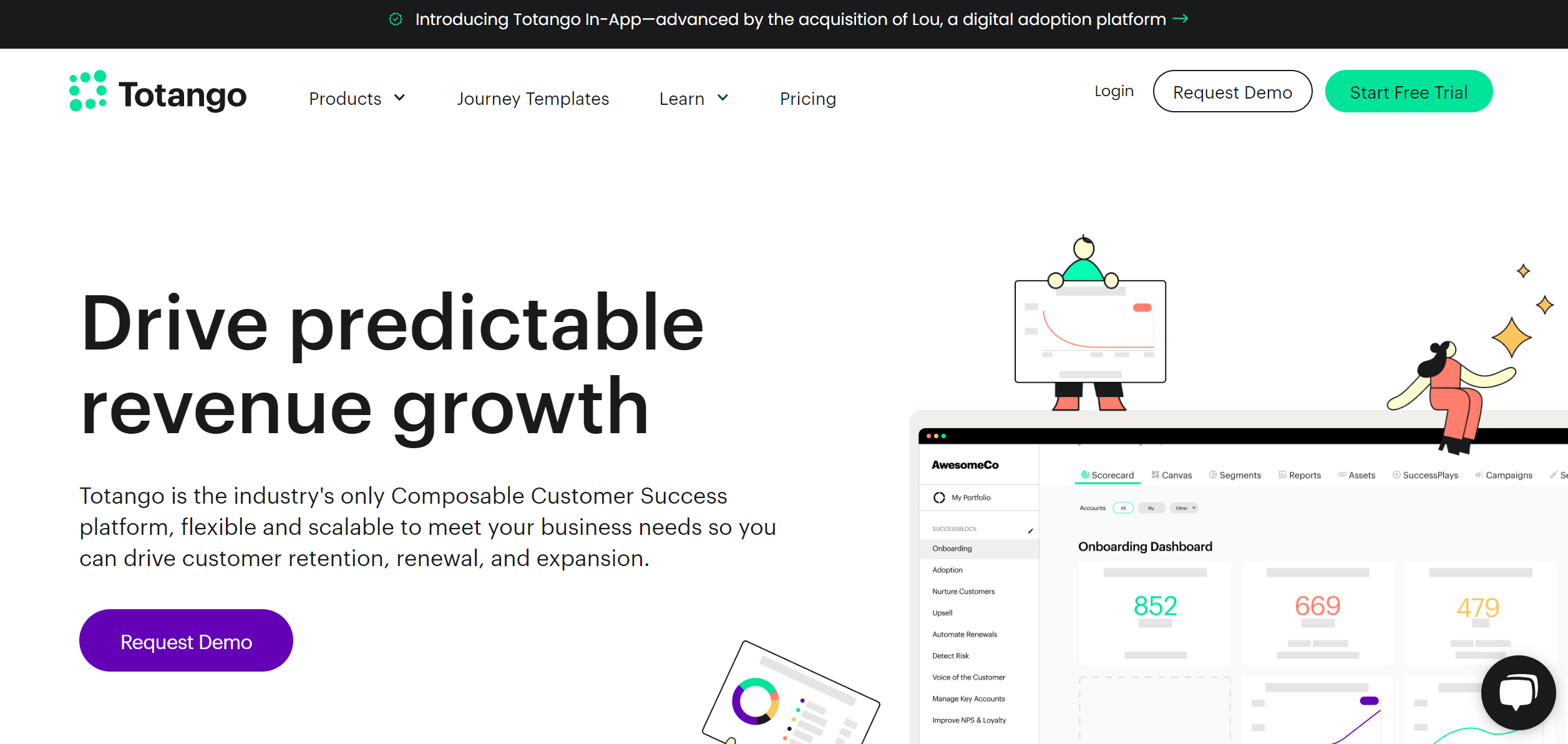
Totango is a comprehensive customer success platform that focuses on driving revenue growth through customer retention, renewal, and expansion. Its key features include Journey Orchestration for creating touchpoints with customers, Data Management and Integrations for connecting customer data streams, and Reporting tools for a 360-degree view of your customer success efforts.
It also offers Portfolio Management for managing renewal and expansion sales processes and User and Account Management tools for aligning customer journeys with business goals. In essence, Totango provides a holistic approach to customer success, creating a customer journey that aligns with your business objectives and enhances customer value.
